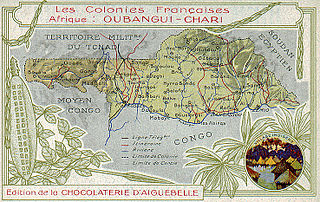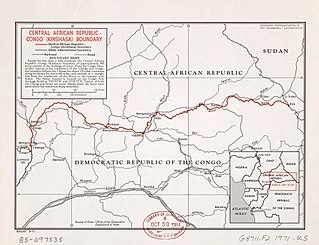
The Central African Republic (CAR), formerly known as Ubangi-Shari, is a landlocked country in Central Africa. It is bordered by Chad to the north, Sudan to the northeast, South Sudan to the east, the Democratic Republic of the Congo to the south, the Republic of the Congo to the southwest, and Cameroon to the west. Bangui is the country's capital and largest city, at the border with the Democratic Republic of the Congo. The Central African Republic covers a land area of about 620,000 square kilometres (240,000 sq mi). As of 2021, it had an estimated population of around 5.5 million. As of 2024, the Central African Republic is the scene of a civil war, which has been ongoing since 2012.

The history of the Central African Republic is roughly composed of four distinct periods. The earliest period of settlement began around 10,000 years ago when nomadic people first began to settle, farm and fish in the region. The next period began around 10,000 years prior.

French Equatorial Africa was a federation of French colonial territories in Equatorial Africa which consisted of Gabon, French Congo, Ubangi-Shari, and Chad. It existed from 1910 to 1958 and its administration was based in Brazzaville.

Bangui is the capital and largest city of the Central African Republic. It was established as a French outpost in 1889 and named after its location on the northern bank of the Ubangi River ; the Ubangi itself was named from the Bobangi word for the "rapids" located beside the settlement, which marked the end of navigable water north from Brazzaville. The majority of the population of the Central African Republic lives in the western parts of the country, in Bangui and the surrounding area.

David Dacko was a Central African politician who served as the first President of the Central African Republic from 14 August 1960 to 1 January 1966 and as the third President of the Central African Republic from 21 September 1979 to 1 September 1981. He also served as Prime Minister of the Central African Republic from 1 May 1959 to 14 August 1960. After his second removal from power in a coup d'état led by General André Kolingba, he pursued an active career as an opposition politician and presidential candidate with many loyal supporters; Dacko was an important political figure in the country for over 50 years.

Ubangi-Shari was a French colony in central Africa, a part of French Equatorial Africa. It was named after the Ubangi and Chari rivers along which it was colonised. It was established on 29 December 1903, from the Upper Ubangi and Upper Shari territories of the French Congo; renamed the Central African Republic (CAR) on 1 December 1958; and received independence on 13 August 1960.

Ubangi-Shari was a French colony in central Africa which later became the independent country of the Central African Republic on August 13, 1960. It followed the establishment of the Bangui outpost in 1889, and was named in 1894.
Each "article" in this category is a collection of entries about several stamp issuers, presented in alphabetical order. The entries are formulated on the micro model and so provide summary information about all known issuers.
Each "article" in this category is a collection of entries about several stamp issuers, presented in alphabetical order. The entries are formulated on the micro model and so provide summary information about all known issuers.

This is a survey of the postage stamps and postal history of Chad.

The Movement for the Social Evolution of Black Africa was a political party in the Central African Republic. In its original form, it was a nationalist quasi-religious party that sought to affirm black humanity and advocated for the independence of Ubangi-Shari, then a French colonial territory.

This is a survey of the postage stamps and postal history of the Republic of the Congo, a former French colony known as Middle Congo or French Congo, and now often known simply as The Congo.
Operation Caban was a bloodless military operation by France in September 1979 to depose Emperor Bokassa I, reinstate the exiled former president David Dacko, and rename the Central African Empire back to Central African Republic.

Fort de Possel was a French garrison and settlement in central Africa which served as the capital of Ubangi-Shari from February 11 to December 11 in 1906. It lies on the northern shore of the main bend of the Ubangi River at the mouth of the much smaller Kémo River. Its importance derived from the use of the Kémo in provisioning Fort Sibut and linking the Ubangi trade with Lake Chad. It was gradually superseded in importance by Bangui further downstream at the head of the navigable portion of the river.

Roger Léon Charles Guérillot was a French colonist of Ubangi-Shari who was involved in the process of independence by which it became the Central African Republic.

Central African Republic–France relations are foreign relations between the Central African Republic (CAR) and France. Both nations are members of the Francophonie and the United Nations.
The following is a timeline of the history of the city of Bangui, Central African Republic.
The Renaissance Palace is the official residence of the President of the Central African Republic, located in the 1st arrondissement of Bangui, at the foot of Gbazabangui Hill and facing the PK zéro.

The Central African Republic–Democratic Republic of the Congo border is 1,747 km in length and runs from the tripoint with the Republic of the Congo in the west to the tripoint with South Sudan in the east.















